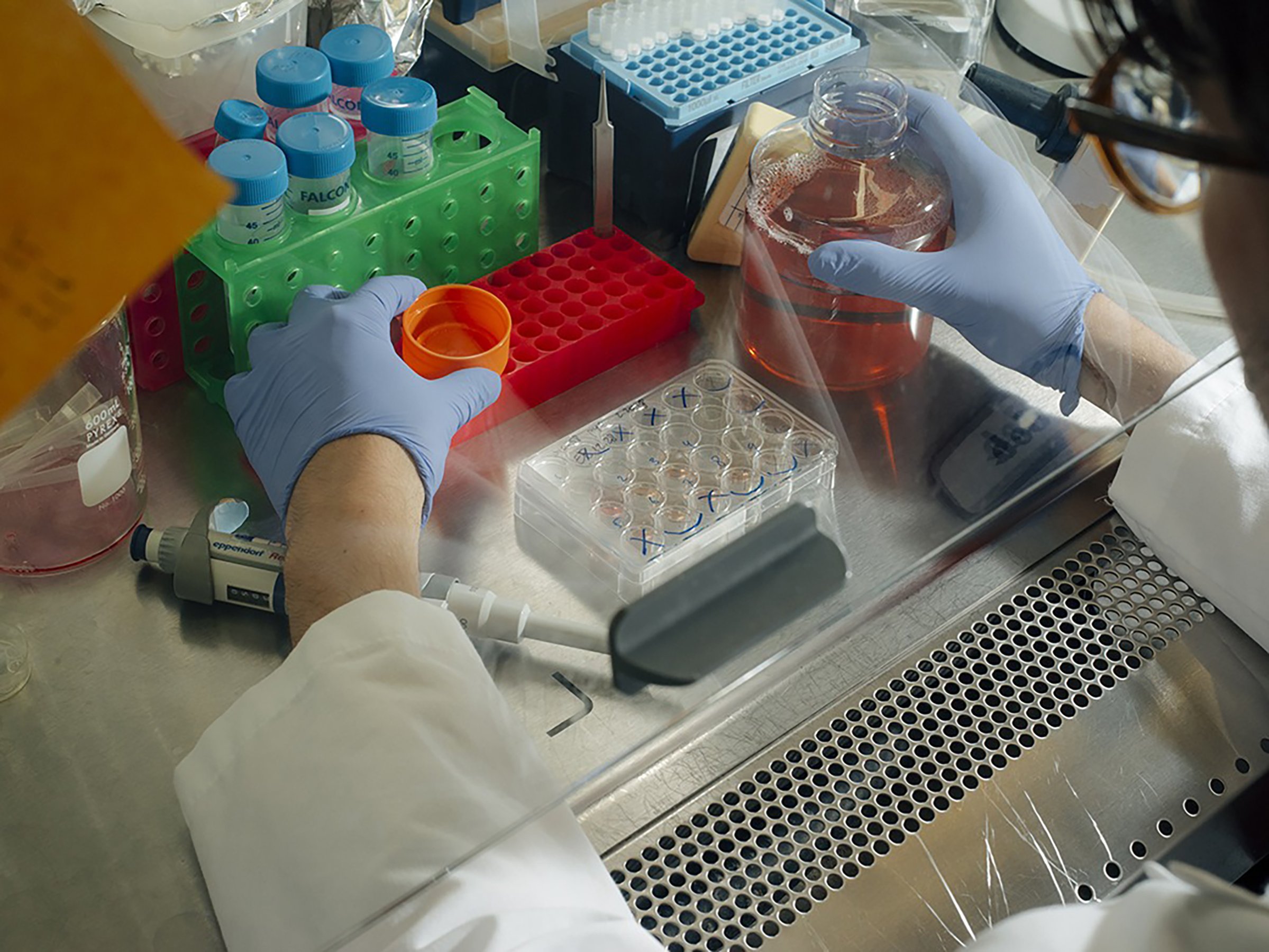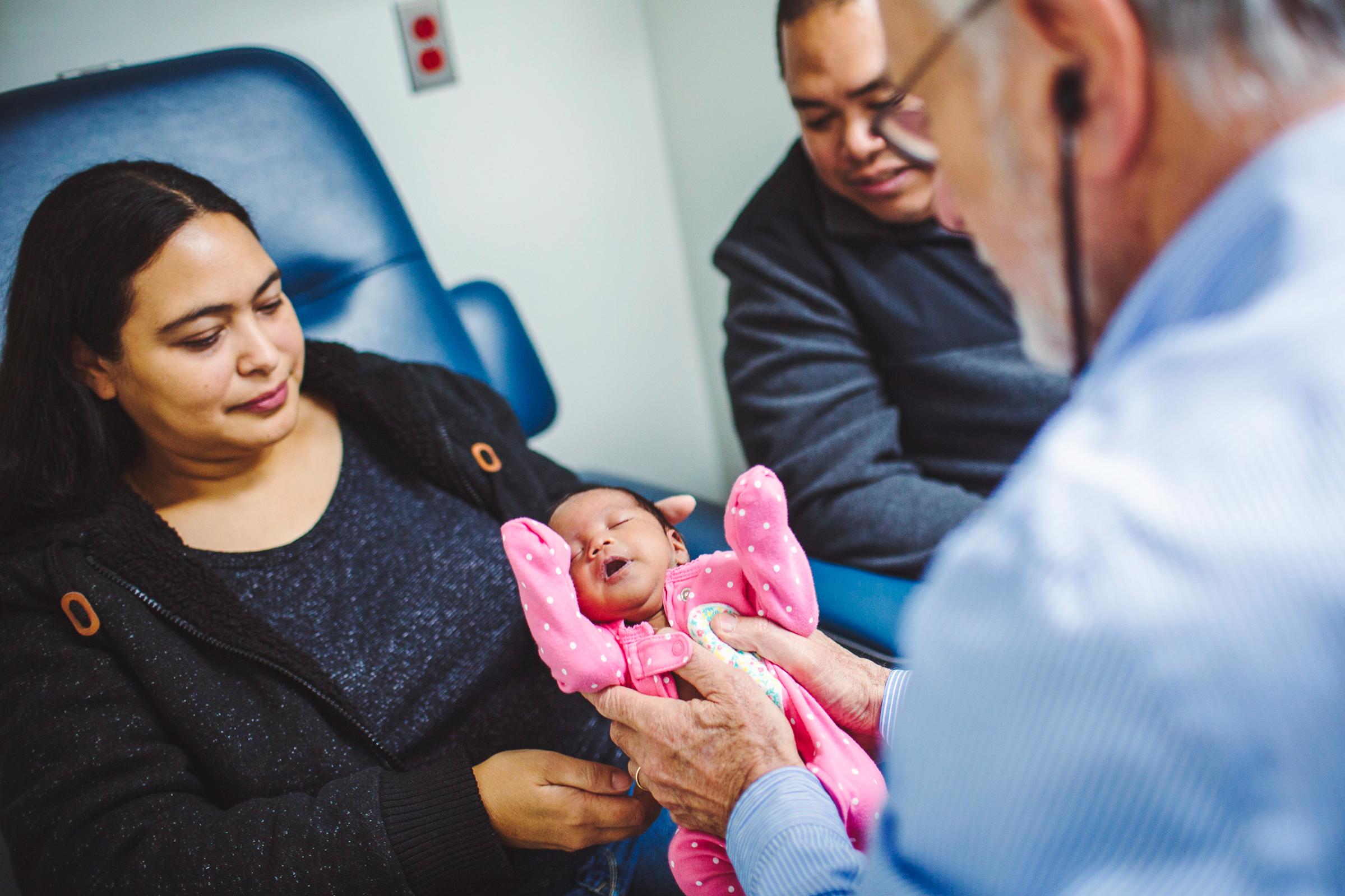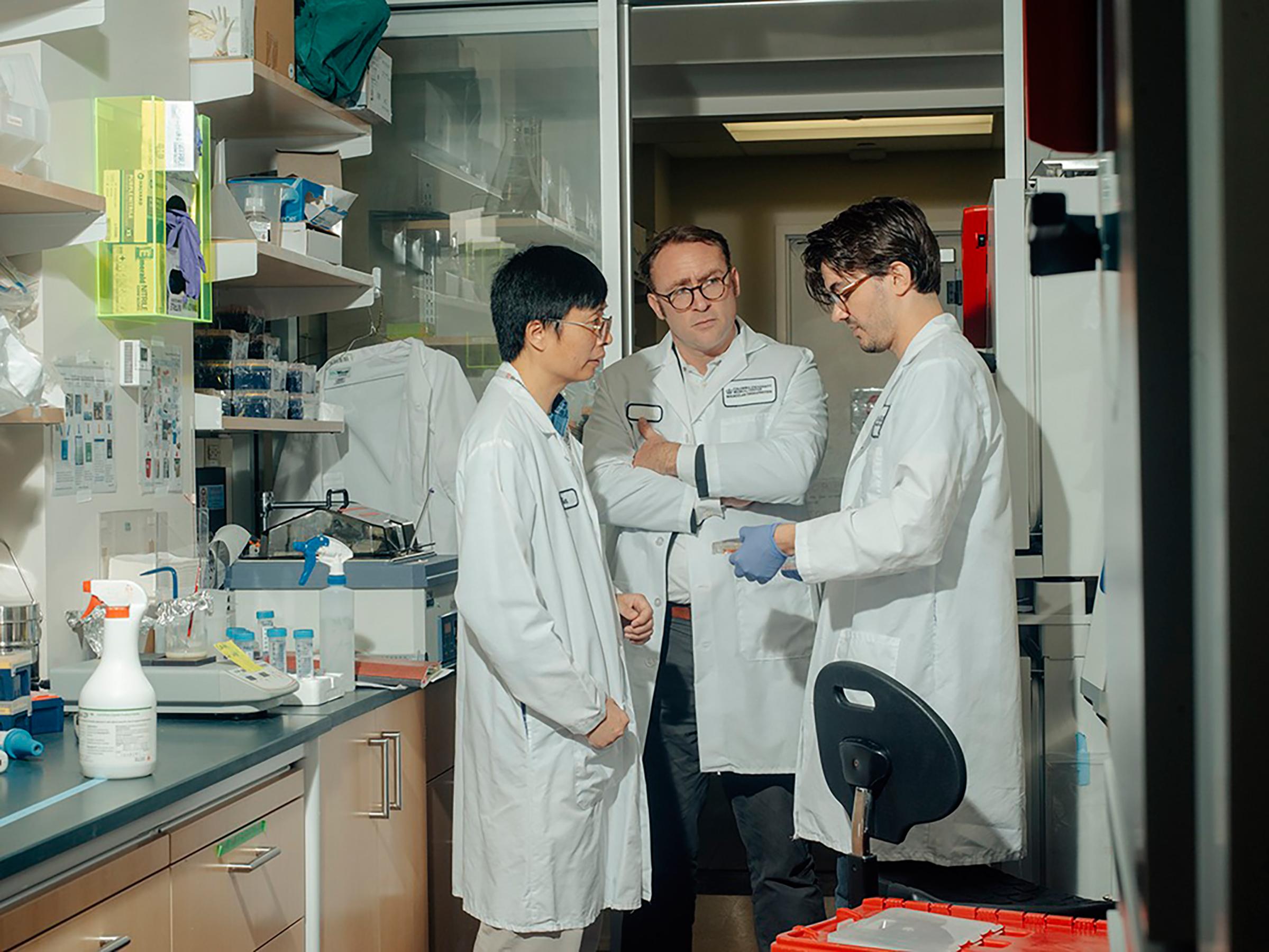
When Nichelle Obar learned she was pregnant with her second child last year, she never expected that her pregnancy, or her baby, would make history.
But when the 40-year-old food-and-beverage coordinator from Hawaii and her fiancé Christopher Constantino went to their 18-week ultrasound, they learned something was wrong. The heart was larger than it should have been, and there was evidence that fluid was starting to build up around the organ as well. Both were signs that the fetus was working extra hard to pump blood to its fast-growing body and that its heart was starting to fail.
Obar’s doctor knew what could be causing it. Obar and Constantino are both carriers of a genetic blood disorder called alpha thalassemia, which can lead to dangerously low levels of red blood cells. Red blood cells carry hemoglobin, which binds to oxygen and transports it from the lungs to feed other cells–so fewer red blood cells means low levels of oxygen in cells throughout the body. Neither parent is affected by the condition, but depending on how their genes combined, their children could be.
When Obar was pregnant with their first child, Gabriel, the couple was told that if he had the disease, his prognosis would be grim. “The information we got was that most babies don’t survive, and if they do survive to birth, they might not live for too long,” Obar says. Gabriel was lucky. The DNA he inherited from his mom and dad did not endow his cells with enough of the mutation to make him sick.
But soon after that 18-week ultrasound, their second baby, a girl, was officially diagnosed with alpha thalassemia. “We were pretty devastated,” Obar says. They did not have many options: their daughter would need blood transfusions in utero just to improve her chances of being born, and even if she survived to birth, she might need regular transfusions for the rest of her life, relying on a healthy donor’s blood to make up for the low oxygen in her own.
Their genetic counselor did have one other suggestion, but it was a long shot. She had just learned about a study at the University of California, San Francisco (UCSF), testing a daring new way to potentially treat alpha thalassemia: a stem-cell transplant given to the baby in utero.
In utero stem-cell transplants had been tried before for the blood disorder but with limited success. Blood stem cells, which develop into all of the different types of blood cells, are extracted from a donor’s bone marrow, processed in a lab and injected directly into the umbilical vein connecting the fetus to the mother’s placenta. Ideally, the donor’s healthy stem cells then start dividing and take over for the fetus’ defective blood cells. But removing bone marrow can be risky in pregnant women, so past trials involving alpha thalassemia used stem cells from fathers, which were often rejected. This new trial challenged the ethical question: Was it worth the risk to the mother in order to possibly save the fetus? There was also a chance the transplant could harm Obar’s daughter more than it helped. But on the basis of new studies suggesting that a developing fetus would tolerate a mother’s transplanted cells better than a father’s, Dr. Tippi Mackenzie, a professor of surgery at UCSF and the leader of the study, believed it was worth a shot.
Obar had concerns, but if the cells worked as they were expected to, it could give her daughter a chance at life, hopefully even a normal life free of her disease. She and Constantino decided to try it. Their daughter would be the first fetus in the world to receive stem cells from her mother in a carefully monitored clinical trial.

While blood stem cells from bone marrow have long been a cornerstone of treating blood cancers like leukemia and lymphoma, Mackenzie’s trial extracting the cells from a pregnant woman to treat a developing fetus in utero is just one of several innovative uses of stem cells to treat a growing list of diseases with cells instead of drugs. And promising studies are inching more of these stem-cell-based treatments closer to finally being tested in people.
With stem cells like those found in bone marrow, scientists are taking advantage of what the body does naturally: generate itself anew. Many of the adult body’s organs and tissues, including fat cells and blood, are equipped with their own stash of stem cells whose sole job is to regenerate cells and tissues when older ones are damaged or die off and which can be harvested for research and growth outside the body.
Some organs are not endowed with these large stem-cell reservoirs, however, most notably the brain and heart muscle. So more than two decades ago, scientists found another source of these flexible cells–in embryos that were donated for research from in vitro fertilization clinics. They learned how to grow these cells in the lab into any cells in the body. That opened the possibility that conditions like heart disease, diabetes or even psychiatric disorders might eventually be treated by replacing damaged tissues or organs with healthy ones, which could provide cures and treatments that didn’t require drugs or surgery.
But using cells obtained from human embryos raised serious ethical questions; because extracting the embryonic stem cells required terminating what some felt was a living human being, for years federal law prevented scientists from using government funds to conduct research on these cells.
Beginning in 2006, scientists found a detour around this ethical roadblock. A Japanese team led by Shinya Yamanaka from Kyoto University showed it’s possible to take a skin cell from any person, erase its life history as a skin cell and return it to the clean slate it had in the embryo–turning it essentially into an embryonic stem cell without the morally complicated provenance. Called induced pluripotent stem (iPS) cells, these malleable cells can be coaxed in a lab dish, with the right cocktail of factors, into becoming heart muscle, brain nerves or insulin-pumping pancreatic cells.
In the quest to try these treatments on patients, there have been false starts. In 2009, the FDA approved the first embryonic-stem-cell clinical trial, which involved transplanting nerve cells made from stem cells into paralyzed people to restore the function of spinal nerves. In initial tests with mice, however, the transplanted cells started to form concerning clumps, which were not tumors but raised enough alarms about the safety of the therapy that the FDA put the study on hold; after resuming the trial, the company conducting the research eventually decided to stop it.
Now, with more years of study and experience, scientists are preparing to test whether stem cells that transform into heart muscle could replace dead tissue after a heart attack, for example, or whether pancreatic cells that can’t produce enough insulin might be replaced with new cells that can do the job in people with Type 1 diabetes. Researchers even hope to one day treat brain disorders like Parkinson’s with new neurons made from stem cells that can replace the damaged motor nerves in the brain that lead to uncontrollable tremors.
“With stem cells we can now get to the root cause of a disease and start looking for cures rather than [treatment] patches,” says Dr. Deepak Srivastava, director of the Roddenberry Stem Cell Center at the Gladstone Institutes and a professor at UCSF.
Not only can stem cells lead to new treatments for diseases where they can replace ailing cells, but they can also provide a critical new way to study conditions that have remained black boxes because scientists simply didn’t have the luxury of studying live cells. Now labs across the country are incubating so-called mini-brains, made up of tens of thousands of brain cells grown from iPS cells, to serve as models for studying psychiatric disorders from autism to schizophrenia. Such knowledge could lead to new treatments in a field where therapies haven’t been as widely successful as doctors hoped.
Putting the entire universe of stem-cell research together, from iPS cells to the new use of blood stem cells that Obar’s daughter received from her mother, Mackenzie says, “it’s an unbelievably exciting time to be in medicine, with all of these things exploding around us.”
Wednesday is feeding day for Dr. Job de Jong’s 300 mini-brains. It takes de Jong, a postdoctoral fellow in the division of molecular therapeutics at Columbia University, a couple of hours to painstakingly suck out the few microliters of waste each ball of brain tissue has generated over the past week with a pipette, being careful not to disturb the cells themselves, and replace the fluid with a pinkish-orange liquid diet of growth factors, nutrients, glucose and protein-building amino acids.
The cells, barely visible at the bottom of tiny wells in the neuropsychiatry lab’s version of an ice-cube tray, are somewhere between a poppy seed and a peppercorn in size. Made from iPS cells, they could provide the first window into understanding what goes wrong when psychiatric disorders strike.
Treatment for psychiatric illnesses still lags behind advances in other diseases, mainly because it’s been nearly impossible to access the living brain for testing. As a substitute, neuroscientists relied on mouse brains, or slides of human brain tissue obtained after people with mental illnesses had died, as their primary source of data. Now Dr. Sander Markx, director of the precision-medicine initiative at Columbia who oversees de Jong’s work on the mini-brains, is hoping it could lead to a pioneering study in using stem cells to find and test new treatments for psychiatric disorders for the first time.
So far, the mini-brains contain the same 20,000 genes that any human cell’s DNA contains and produce all of the relevant proteins that any brain cell would. (Because they lack all the structures of a whole brain, however, Markx and de Jong prefer to call them “organoids.”) The balls of brain tissue he is nurturing came from iPS cells generated from people in the Amish community. Some are from healthy people, others from those affected by a rare genetic brain disorder that involves autism-spectrum symptoms, intellectual disability and epileptic seizures. The stem cells were developed into the brain organoids to study how that genetic aberration affects normal brain development. “Now we have this opportunity to study the processes of how [brain cells] grow and develop and observe them in the lab,” de Jong says. He and his team are investigating how closely the organoids replicate actual disease processes in people and are hoping to eventually use the mini-brain cells to screen for promising drugs that may undo the effects of the mutation.
Scientists are also making headway in regenerating tissues and parts of organs to simply replace ones affected by disease. People with cancer whose windpipes or urethras have been destroyed by tumors, for example, can grow new ones from their own cells, reducing the risk of rejection from a transplant.
One early trial to treat macular degeneration, completed in 2014, is already showing promising results in patients. The trial involved growing embryonic stem cells obtained from IVF embryos into retinal pigment epithelial cells, the same cells that start to degrade in people with the disease, eventually robbing them of their sight. The cells were then introduced into the eyes of patients to replace their failing retinas. After nearly two years, more than half of the small number of people who were legally blind at the start of the study have reported some improvement in their vision.
Treatments are also beginning to take advantage of iPS technology to make adult stem cells act as if they’re embryonic–sidestepping the ethical concerns that cling to the real kind.
The process is especially critical for healing the human heart. Adult heart muscle no longer divides, or it divides so infrequently that when heart tissue is damaged–as in a heart attack–it doesn’t regenerate. Instead it turns into scar tissue, hampering the heart’s ability to pump blood. But Srivastava of the Gladstone Institutes has found that in a developing fetus, heart-muscle cells are actively dividing in order to form the heart, and he isolated four genes that are turned on during that period and then switched off at birth to stop heart cells from continuing to divide. Reactivating those genes in healthy adult heart cells made them divide again. And turning on embryonic genes even in scarred heart tissue converted those cells into new muscle as well. “We figured out what nature’s toolbox is for making the heart in the embryo,” he says, “and we redeployed the same cues in the adult to reprogram support cells to becoming new heart muscle.”
Srivastava says the strategy may be useful not only for producing new heart muscle but for growing other types of cells too. In late 2016 he co-founded Tenaya Therapeutics to refine the technique, and the company is now preparing a treatment to test in patients.
Such stem-cell-based biotech companies are popping up throughout the country to address different types of diseases. At Semma Therapeutics, based in Cambridge, Mass., Douglas Melton, a co-director of the Harvard Stem Cell Institute, is pursuing ways to generate a population of insulin-pumping pancreatic cells from people affected by Type 1 diabetes, like his two children. His latest studies showed that the cells, made from iPS cells, can detect and respond to changing levels of sugar and effectively dial up and down how much insulin they produce. But with Type 1 diabetes, replacing these cells with new ones from stem cells doesn’t solve the entire problem, since the immune system seems to be attacking the pancreatic cells. So he and his colleagues at Semma developed a way to protect the newly formed insulin-making pancreatic cells from destruction by encasing them in a membrane that can slip past the immune system. Melton hopes to test that delivery system, and his insulin-making cells made from stem cells, in the next two years. “Insulin was discovered in 1920, and I like the idea that at the 100-year mark we may be done injecting insulin,” he says.
As with any emerging technology, the opportunities that stem cells represent have also been shadowed by the potential for exploitation. A report published in the New England Journal of Medicine in 2017 described a study in which retinal cells created from stem cells extracted from patients’ own fat cells were transplanted to treat macular degeneration; it was shut down after three people in the trial were left with severe vision loss following the treatment. A review of the trial revealed that the volunteers paid the company running the study for the experimental treatment, which is unusual for clinical trials. The review also exposed irregularities in how the people were recruited and informed about the study, and raised questions about exactly what types of cells the people received.
“Whatever we take forward to test clinically, we’d have to make sure the therapy we are using is safe,” says Srivastava.

Obar’s fears about being the first pregnant woman to use her own stem cells in a study to treat her baby’s alpha thalassemia in utero were quickly assuaged when she watched the blood transfusions take place. “I watched on a video the stem-cell machine and saw the white dots that were the stem cells swirling in the needle that was going into me,” she says. Her daughter received five transfusions via an injection into the umbilical vein through Obar’s abdomen. “I was just blown away by how it looked,” she says. “It was pretty cool.”
For Obar, the possibility that the stem cells could become a permanent fix for her daughter’s condition was worth the risks of being the pioneer. And the procedure does seem to be working. Before the birth, Obar’s doctors warned her that her daughter might look blue when she took her first breaths and that she might seem weaker than other newborns. But not only did her daughter continue to survive the pregnancy, but she also let out a lusty cry when she was born that immediately put Obar’s mind at ease. Now 7 months old, the baby, whom they named Elianna, is eating well and working on rolling over. There’s still a chance she may show some developmental delays and cognitive effects from her condition in the future, but Obar and Constantino are hoping for the best.
Mackenzie gives Elianna another blood transfusion once a month, just to be safe, and plans to continue monitoring her carefully for a year to look for signs that Obar’s blood cells are starting to populate her daughter. Depending on how well Elianna does, Mackenzie plans to enroll more expectant mothers whose babies are affected by the blood disorder in the study.
The scientific impact of Mackenzie’s history-making stem-cell trial may be yet unknown, but the impact on the family is right there in the baby’s name. “I wanted a name to signify the fighter she is and what she went through,” says Obar. Throughout her pregnancy, none seemed quite right until she met the nurse who helped with her daughter’s first in utero blood transfusion. The nurse’s name was Elianna, which she learned means “God has answered.” “It’s perfect,” Obar says.
More Must-Reads from TIME
- Why Biden Dropped Out
- Ukraine’s Plan to Survive Trump
- The Rise of a New Kind of Parenting Guru
- The Chaos and Commotion of the RNC in Photos
- Why We All Have a Stake in Twisters’ Success
- 8 Eating Habits That Actually Improve Your Sleep
- Welcome to the Noah Lyles Olympics
- Get Our Paris Olympics Newsletter in Your Inbox
Contact us at letters@time.com